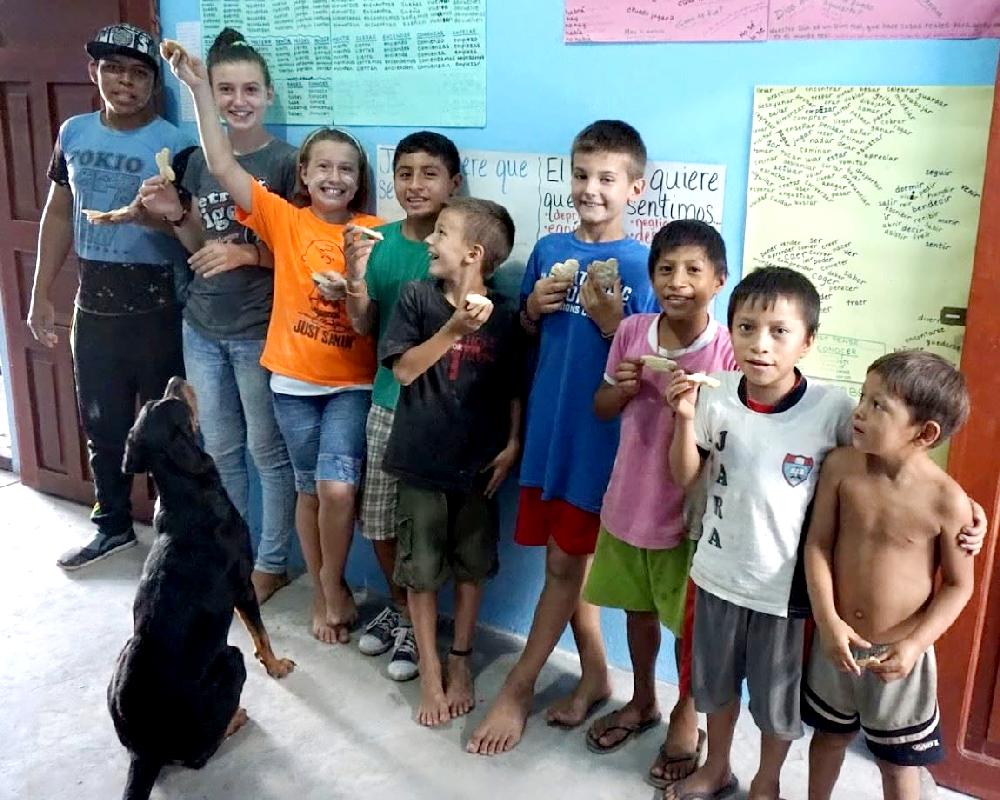
Christian Missionaries: Latin America

Figure 1.--This photo shows the four children of an American Catholic family with local mates and a pooch in Peru. The family serves in a mission in Peru They belongs to an organization called Family Missions Company. Traditionally Catholic missionnaries are priests and nuns, but nowadays there are also some families, usually engaged in teaching or socio- sanitary programs. These missionaries kids, as many others, took on habits similar to those of their local mates.
|
|
The Christian Church's focus for a millnium was on Europe. The first foray out of Europe was into the Middle East, but that was to recover the Holy Lnd, not to convert hethans. The first major missionary effort outside of Europe was to the Americas with the Portuguese and Spanish conquest. The Catholic Monarchs of Spain financed the voyage of Christopher Columbus to open trade with the Eest (1492). With his discoveries it soon began to gain territory and win souls. Pope Alexander VI published a bull dividing the new territories being duscovered between Spain and Portugal, as long as they converted the indigenous population to Catholicism (1493). The treatment of the indigenous population led to a debate as to the humanity of the indigenous population. The Catholic fathers defended the natives. The Church moved to implant Catholocism. Hernán Cortés in the process of destoying the Aztec Empire held a letter of instrction from the Crown which read, “The first aim of your expedition is to serve God and spread the Christian faith.” Catholic fathers accompanied the Conquistadores as they conducted their conquests from one end of what was to become Latin America to another. A Catholic father presented the Inca Emperor Atahualpa a Bible before Francisco Pizarro seized him. The Cathiolic Church fiercly pursued a missionary effort. The Church with the aid of the Conquistadores swords eradicate the indigenous religions and cultures of the great civilzations. Most of the missionary work was done by Catholic orders: the Franciscans, Dominicans, Augustinians, and Jesuits. Only a generation after the first dozen Franciscans arrived, there were 800 missionaries in Mexico alone. Contemporary reports claim that the Franciscans alone baptized 5 million, something like 1 percent of the world population at the time. The Spanish conducted forced mass conversions. (The Portuguese did not encounter an advanced civilization.) The first Christian missions were established in both South America and North America into what is now the American Southwest. The missions in Paraguay and the American Southwest, both border regions, are the best known, but not the only ones. The priests founded new towns and villages for their new converts. They constructed huge churches, in ome cases larger than many of the cathedrals in Europe. The Jesuits along the bordr between Spain and Portugal add a milotary spin. Hundreds of thousands natives were settkled in Jesuit-run autonomous colonies. There were even Jesuit armies formed to protct the missions. The Inquistion prevented the entry of Protestants. This chnged with independence (19th century). After World War II, Protestant missionaries became active in Latin America and has attracted many devoted followers. Notably men commonly attend Protestant services which is commonly not the case in Catholic churches. Also we notice that Catholcism in the region tends to have a strong socialist flavor, exemplified by Pope Francis. While Protestantism has a strong capitalist ethnic.
HBC

Navigate the Boys' Historical Clothing Web Site:
[Return to Main country missionary page]
[Return to Main Latin American religions page]
[Return to Main Latin American independence page]
[Return to Main Spanish Inquistion page ]
[Return to Main Catholic missions page ]
[Return to Main Spanish Empire page]
[Introduction]
[Activities]
[Biographies]
[Chronology]
[Clothing styles]
[Countries]
[Bibliographies]
[Contributions]
[FAQs]
[Glossaries]
[Images]
[Links]
[Registration]
[Tools]
[Boys' Clothing Home]
Created: 2:08 AM 8/7/2012
Last updated: 9:12 AM 11/12/2018



